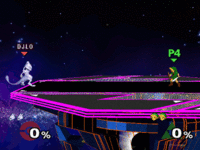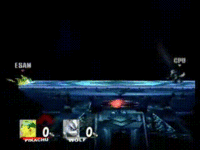B-reversing
B-reversing is the act of performing a special move and changing the direction the character is moving at the same time. This technique is closely related to the turnaround-B and the wavebounce.
Specifics of each technique[edit]
B-reverse[edit]
B-reversing was first introduced in Super Smash Bros. Brawl, and is retained in Super Smash Bros. 4 and Super Smash Bros. Ultimate as well. To execute a B-reverse, the player must input a special move, then quickly tap the direction opposite the one they are facing. If performed correctly, their character will do the special move while turning around and reversing their momentum. In Ultimate, the direction input must be within 4 frames of the special input.
The momentum shift happens almost instantly and is very useful. For example, Mario can jump away from his opponent, as if to retreat, then B-reverse a Fireball to close distance while landing behind a projectile. Diddy Kong is able to gather lots of momentum with his Monkey Flip, then B-reverse his Peanut Popgun on a moment's notice to avoid or attack his opponent. Even better, the popgun can be canceled with the shield button, making this an especially flexible movement option. Snake sees just as much use out of the technique, as he can B-reverse with Grenades and C4 to avoid being juggled by opponents after recovering high above the stage.
Not every special move can be B-reversed, however. Some examples include Samus's Charge Shot (prior to Ultimate) and Mewtwo's Disable. Captain Falcon's Falcon Punch, Ganondorf's Warlock Punch, Mii Brawler's Exploding Side Kick and Byleth's Aymr are unique in that they cannot normally be B-reversed, but attempting to do so results in those characters physically turning themselves around while performing those moves. In the case of Exploding Side Kick (in Ultimate only), Falcon Punch and Warlock Punch, pulling this off results in even more damage and knockback, but it also slows the attacks down even more. This is a move-specific technique and is not technically a B-reverse; it is also easier to perform than an actual B-reverse due to its more lenient window.
Turnaround-B[edit]

This technique, also known as a B-turnaround or a turnaround special, has been present in every Smash Bros. iteration. However, before Ultimate, it could only be performed in the air. In Ultimate, the new dash cancel mechanics now allow characters to perform grounded turnaround-Bs out of a full run.
A turnaround-B will cause the character to change the direction they are facing right before starting the special move. While B-reversing requires a direction to be input right after a special move, a turnaround-B is done by tapping the direction away from where the character is facing before the special move. In the case where the player wished to do a turnaround neutral special, they must be sure to let the control stick reset to a neutral position before pressing the special button.
Turnaround specials are quite common. For example, when a player reverses the direction of their up special to recover, they are performing a turnaround up special. In Melee, Falco will often perform a turnaround-B to shoot a laser at his foe when he retreats with a short hop laser.
In Smash 64, while reverse neutral special moves do not exist, it is possible to turn around while performing a neutral special move by simply tilting the Control Stick left or right, as side specials do not exist in this game.
Wavebounce[edit]
Performing a wavebounce, sometimes referred to as a recoil special, is actually a matter of performing both a turnaround-B and a B-reverse within the same special move. The result is that the character will change the direction they move, but not the direction they are facing. Wavebouncing is less common than using either of the techniques alone due to its difficulty, but it does offer players a unique way to position themselves as they shoot projectiles or space certain attacks.
Due to the dash cancel mechanics in Ultimate allowing grounded turnaround-Bs to be performed, it is now possible to perform a grounded wavebounce.
C-bounce[edit]
A variant of the wavebounce exclusive to Smash 4 and Ultimate that involves setting the C-stick to perform tilt attacks. Before performing the desired special move, press the C-stick in the opposite direction the fighter is moving at the same time. If done correctly, the wavebounce will activate with less inputs and more lenient timing than the traditional method. The C-bounce can be performed in the air in all games it appears in. Ultimate introduced the grounded C-bounce, but it only activates with a full dash.
There are some caveats to performing the C-bounce. The most obvious is the technique requiring a custom controller layout that many might not be used to. Also, some special moves, like counterattacks, do not work due to stopping all momentum. The C-bounce, just like the wavebounce, also has varied usefulness from fighter to fighter.
B-sticking[edit]
B-sticking refers to a control scheme that sets the C-stick to input special moves. Some players prefer to use B-sticking to simplify the inputs required to perform B-reverses and wavebounces, among other applications.
Setup[edit]
B-sticking requires that the player be using the GameCube, Classic Controller/Classic Controller Pro, Wii U Pro Controller, Wii U GamePad, Nintendo Switch Pro Controller or dual Joy-Con. The player must then go to Options → Controls and change the control scheme for the controller for their name. The primary change that needs to be made is that the C-Stick must be changed so that instead of performing smash attacks, it executes special moves. This also gives B-sticking its name, since the player is using the C-Stick to perform special moves.
Applications[edit]
Dashing up special[edit]
Similar to how an up smash can be performed out of a dash, but with this setup, an up special can be performed much the same way. To do this, start to dash, and just before reaching the point where the player wants to perform the up special, press back on the joystick and then up on the C-Stick. The character should continue to slide forward and begin to perform their up special. This technique also works with down specials (such as the Luigi Cyclone).
Reverse aerial rush[edit]
The B-sticking setup can be used to more easily perform a back aerial out of a dash by pressing the C-Stick backward while running. This will cause the character to turn around and jump while still moving forward. This does not work in Ultimate, however, as attempting to do so merely results in the character performing their side special in the opposite direction without jumping.
Characters who greatly benefit[edit]
The following characters have a very noticeable recoil on one or more of their specials with practical applications:
- Lucas
- Ness
- Marth
- Lucina
- Lucario
- Zelda
- Pikachu
- Pichu
- Link
- Young Link
- Toon Link
- Zero Suit Samus
- Donkey Kong
- Charizard
- Snake
- Mario
- Ryu
- Ken
- Olimar
- R.O.B.
- Kirby (with a copy ability from any character who can normally B-reverse their neutral special)
- Shulk (upon an aerial Monado Art activation)
- Luigi
- Roy
- Chrom
- Bowser
- Dr. Mario
- Yoshi
- Robin
- Mii Brawler
External links[edit]
- My Smash Corner's Wavebounce & B-Reverse Tutorial (Smash Wii U/3DS)
- Turnaround-Bs, B-reverses and Wavebounces: Know the difference!
- Thread in Smash Boards about B-Sticking
- Panda's Video Documenting B-Sticking Setup and Applications
Other B-sticking videos
- Zero9teen's B-sticking/Wavebouncing video
- Zero9teen's Wavebounce Character Demonstration Part 1
- Zero9teen's Wavebounce Character Demonstration Part 2
- C-bounce tutorial in Smash 4
- C-bounce tutorial in Ultimate
